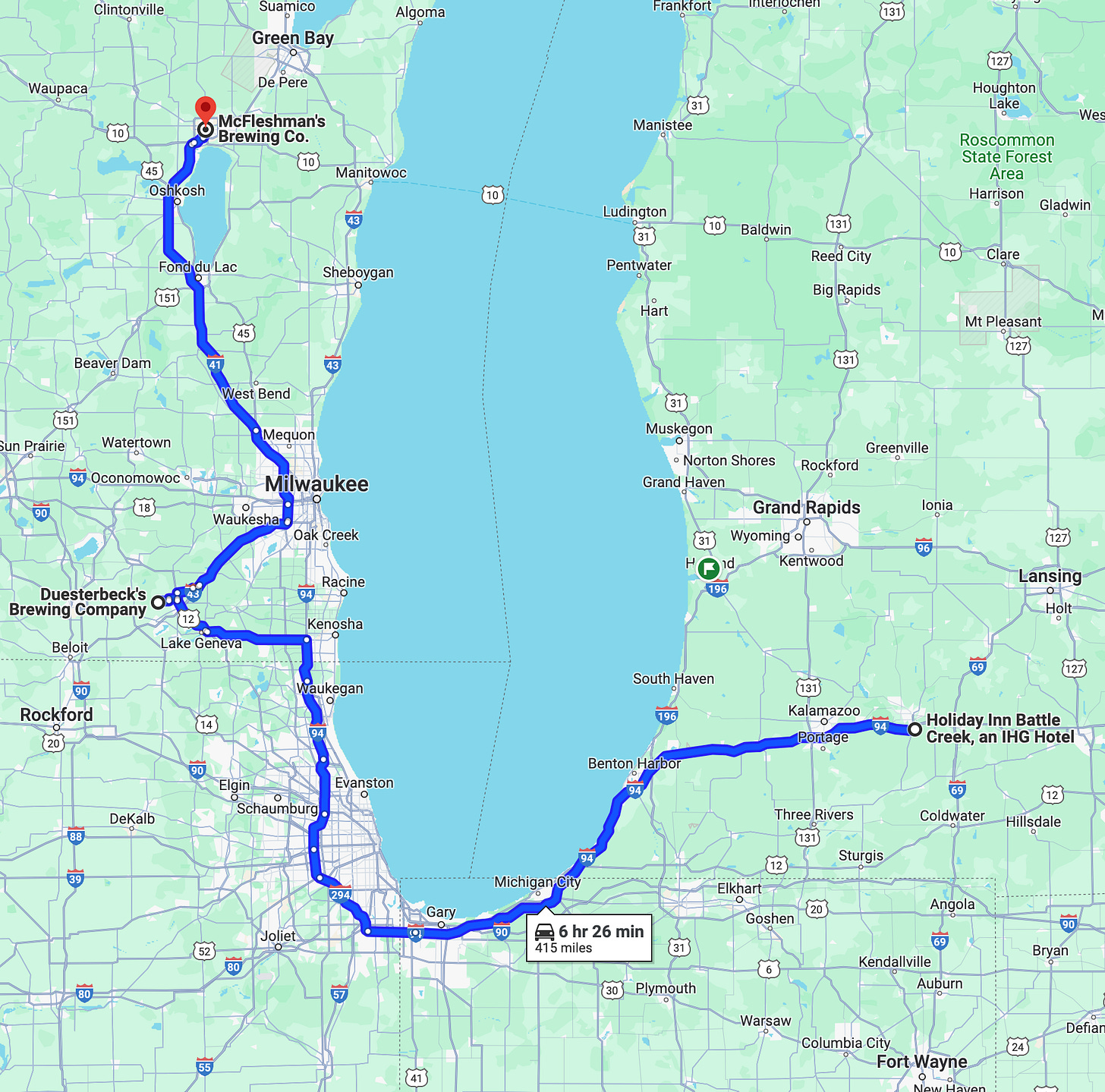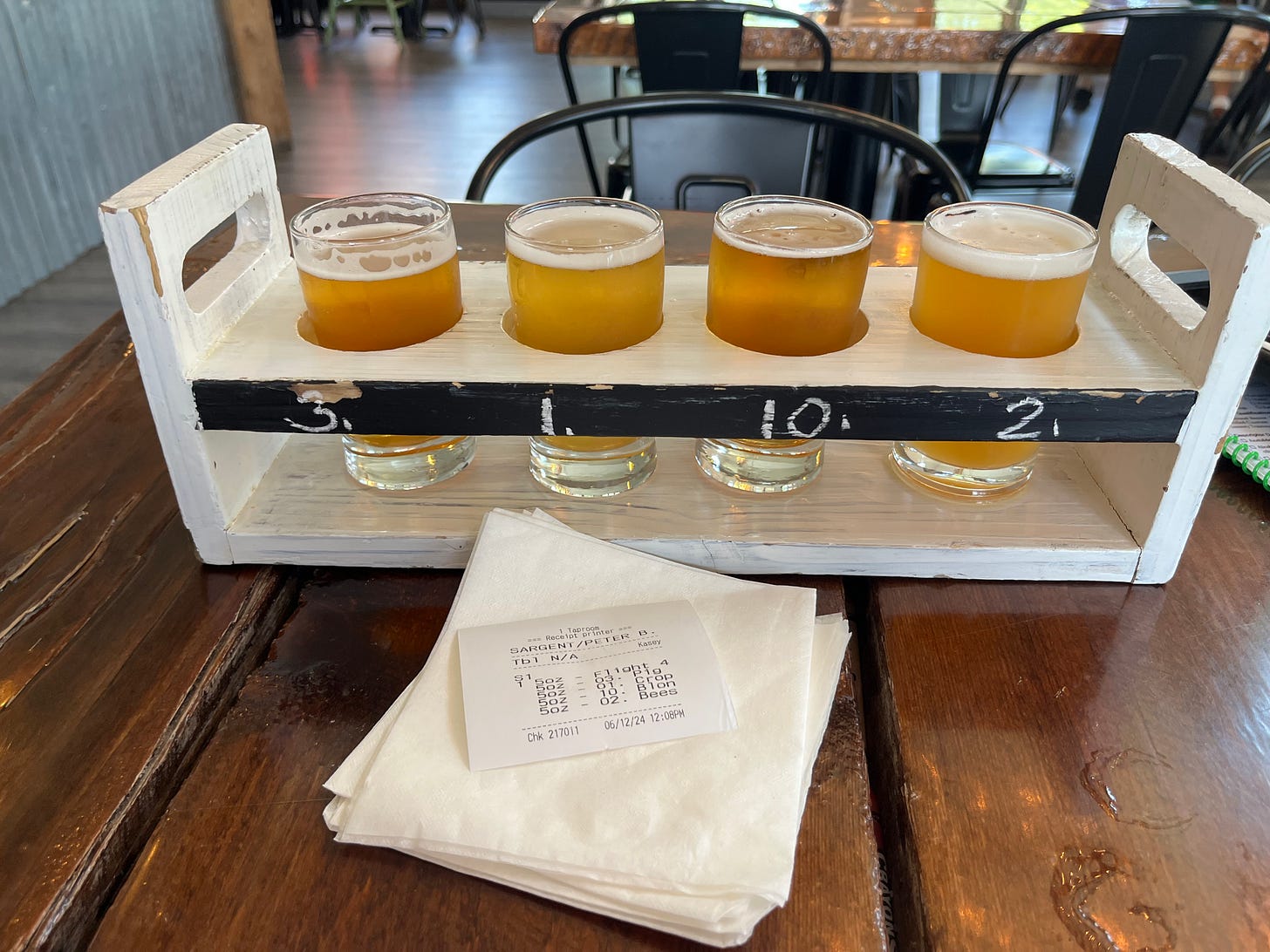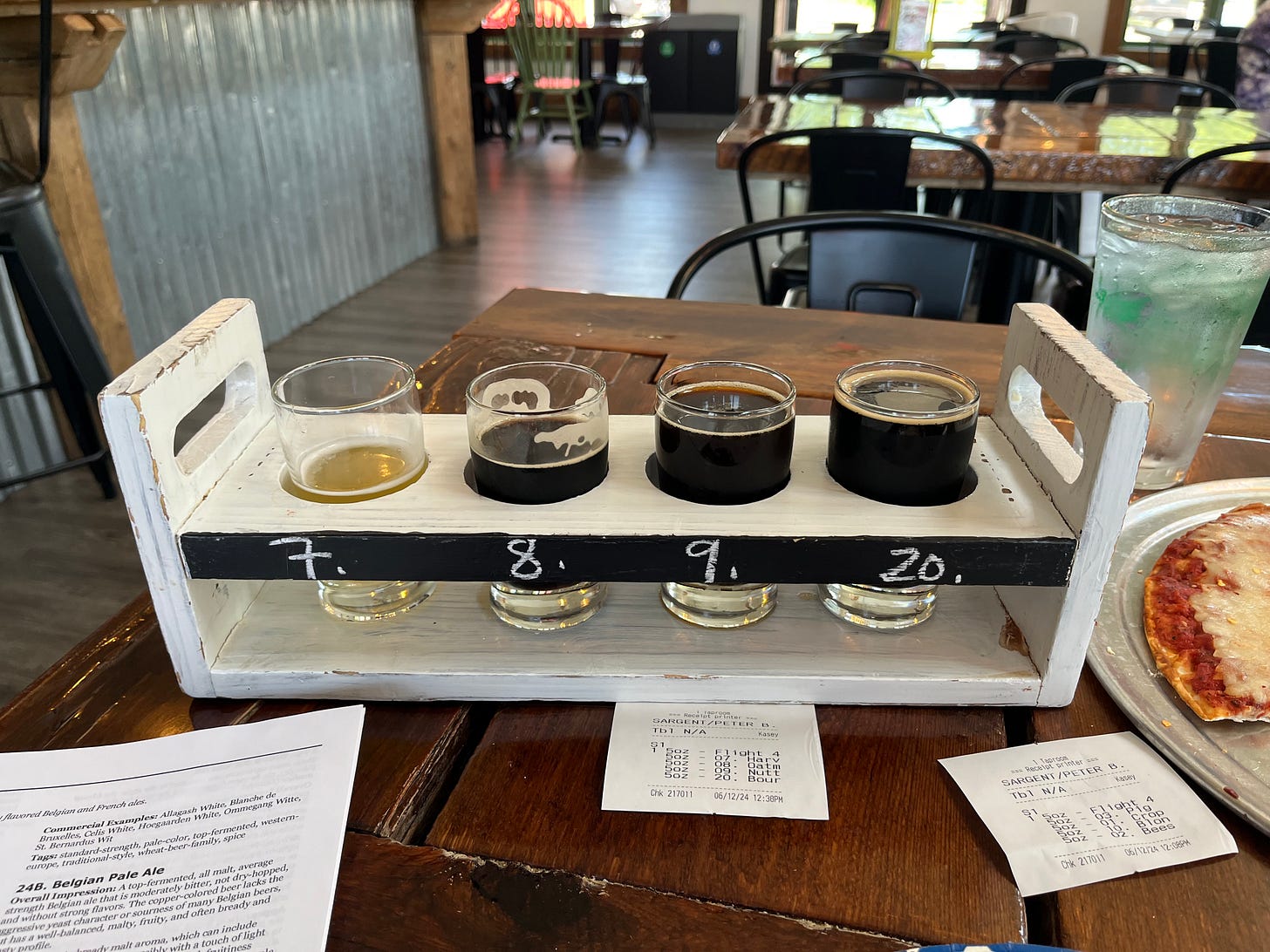Greetings neighbors, friends, and singers,
This is the third of my posts about my recent Beer Tour of Michigan, Wisconsin, and Minnesota.
My beertinerary for this trip was as follows:
Monday, June 10 - Founders Brewery, City Built Brewing Company and Brass Ring Brewing Company (all Grand Rapids MI)
Tuesday, June 11 - New Holland Brewing Company (Battle Creek, MI) and Bell’s Eccentric Cafe (Kalamazoo, MI)
Wednesday, June 12 - Duesterbeck’s Brewing Company (Elkhorn, WI) and McFleschman’s Brewing (Appleton, WI), and
Thursday, June 13 - Yard House (St. Louis Park, MN).
St. Louis Park, a suburb of Minneapolis, was home to a number of influential Americans, including the Coen Brothers, Senator Al Franken, the New York Times reporter and author, Thomas Friedman, and finally, the REAL Charlie Brown (no kidding, check it out!).
On the morning of June 12th, I set out from a Holiday Inn in Battle Creek for Duesterbeck’s Brewing Company in Elkhorn WI, where I had lunch (and beer), and then for McFleschman’s Brewing in Appleton WI, where I was meeting up with dear friends whom I have known for more than 40 years. This was, as they say in the business, a travel day (400 miles, with hour upon hour of slow-and-go through Chicago). I moved from Eastern to Central Time during the day, a fact that I was not aware of until I arrived at Duesterbeck’s before they opened.

From the perspective of a city dweller, Duesterbecks is in the middle of nowhere, which is to say “farm country.” I arrived soon after they opened, or so I thought, and as I walked from my car across the dirt parking area, a woman talking with others across the parking area told me “You know that we don’t open until noon.” I looked at my watch and saw that it was about 11:30 am. I had arrived an hour earlier than planned because I had forgotten about the time change. I thought that time changes only happened when you were in transit in an airplane!
The woman, who introduced herself as Laura, invited me to sit in the shade in a patio area behind the building that served as the pub. She sat down and told me a bit about the place; she is the sixth generation of her family to own the farm, as it once was. In the 1980s her father was having difficulty making ends meet as a diary and pig farmer. During that time small farms were struggling. The crisis began in the 1970s, when the Nixon administration and its Secretary of Agriculture, Earl Butz, encouraged farms to expand to achieve economies of scale. As Butz put it, “Get big or get out!” Farmers were urged to borrow to expand and, at least temporarily, the demand for their products were bolstered by American farm imports to the USSR. But then, with the invasion by Russia of Afghanistan, President Carter banned exports to the USSR, and there was a collapse in prices of some farm goods. This, was followed by the extraordinary inflation of the early 1980s and by a drought year in 1983. At one point in the 1980s American farms held two-thirds of the entire nation’s debt! During this time, Laura Duesterbeck’s dad sold off his herds and closed the farm, and for two decades Laura watched as the buildings began to yield to the forces of nature.
Laura’s Duesterbeck’s husband, Ben Johnson, was a home brewer and was thinking of quitting his dental practice and becoming a commercial brewer. Laura convinced him to site the brewery on the family farm and to restore the buildings and convert them into a brewing facility. One of the most challenging aspects of the entire multi-year process was convincing Walworth Country to list the microbrewery as an agricultural business, which they eventually did.
Laura and Ben opened to the public in October of 2019 (ouch! talk about timing!), but I am happy to report that they survived the pandemic. From the size of the numbered parking areas adjacent to the buildings, they appear to be thriving.
At Duesterbeck’s I had two flights (again!).

The first flight was (l. to r.) Pig Farmer (Pale Ale), Crop Duester (get it?) (Cream Ale), Barn Quilt Blondie (Blonde Ale), and Bees Be Crazy (Hefeweizen, or Weissbier). I did a BJCP Score Sheet for each of these and will cover two of them here.
The Crop Duester (Cream Ale) was terrific. Here is the BJCP’s Overall Impression of this beer:
Overall Impression
A clean, well-attenuated, highly carbonated, flavorful American “lawnmower” beer. Easily drinkable, smooth, and refreshing, with more character than typical American lagers, yet still subtle and restrained.
Aroma - 8/12 - corn, sweetness, hint of DMS (dimethyl sulfoxide) (appropriate for style)
Appearance - 2/3 - not completely clear
Flavor - 20/20 - bright, acidic, clean, no DMS
Mouthfeel - 5/5 - high carbonated
Overall Impression - 8/10 - great lawnmower ale
TOTAL - 43/50 - “Excellent” - “Exemplifies style well, requires minor tuning”
The Bees Be Crazy (Hefeweizen, Weissbier) was very good, but I detected what I think is a flaw.
Overall Impression
A pale, refreshing, lightly-hopped German wheat beer with high carbonation, dry finish, fluffy mouthfeel, and a distinctive banana-and-clove weizen yeast fermentation profile.
Aroma - 8/12 - estery, banana, but also bubblegum
Appearance - 3/3 - hazy, golden
Flavor - 16/20 - banana
Mouthfeel - 5/5 - high carbonated, dry, light-bodies
Overall Impression - 7/10 - too much bubble gum
TOTAL - 37/50 - “Very Good” - “Generally within style parameters, some minor flaws”
A little bit about “bubblegum”
The flavor that humans associate with bubblegum seems to be a combination of flavors that are produced when one mixes “banana” and “strawberry.” Banana flavor is largely sensed by the compound isoamyl acetate.
while strawberry is predominately sensed by Ethyl methylphenylglycidate, a compound also called strawberry aldehyde:
During fermentation yeast cells produce thousands of different metabolites, including these compounds. The temperature during fermentation greatly influences how much of these compounds are produced, with more being produced at higher temperature, and it also affects the balance among the different metabolites. According to Ballast Point Brewing, raising the fermentation temperature from 68 F to 76 F will tip the balance from “banana” in the direction of “bubblegum”. If so, then the brewers at Duesterbeck’s could, if they wished, mute the “bubblegum” in their Bees Be Crazy by fermenting at a slightly lower temperature.
This section modified on 6/20/24 based on feedback from SF Homebrewers Guild member and beer competition awardee George Brooks.
Another of the smells that is a hallmark of Weissbiers is clove; the sense of clove in these beers is strongly driven by the presence of 4-vinyl guaiacol:
Interestingly, the structurally related compound in cloves themselves that imparts this same sensation is eugenol (below), which has one additional methylene in the chain leading from the phenolic ring to the unsaturated C-C bond (=CH2).
There is some evidence that the relative amount of “clove” vs. to “banana” can also influence the sense of “bubblegum.” It’s complicated.
I rated the Crop Duester (Pale Ale) a 40/50 (Excellent) and the Barn Quilt Blondie (Blonde Ale) a 38/50 (at bottom of Excellent; here I thought that it wasn’t malty enough).
For my second flight I had Harvest Moon (Belgian White), Oatmeal Snout, Nutty Bill’s (Peanut Butter Porter), and Bourbon Barrel Aged AgRONomy (Imperial Stout).

I didn’t rate these; my cognitive faculties has lost their edge. All were good, or great, except for the Peanut Butter Porter - I have yet to find one of these that I like, so we won’t blame the brewer.
Next stop: McFleshman’s Brewing Company in Appleton, but since I am near my size limit for this post, I will cover that later.
Cheers,
Peter
So much beer, so little time.
“The best beer is the one in your hand”
(Ruben Schneider, who helped establish the brewing program at UC Davis).
(newsletter #138)









